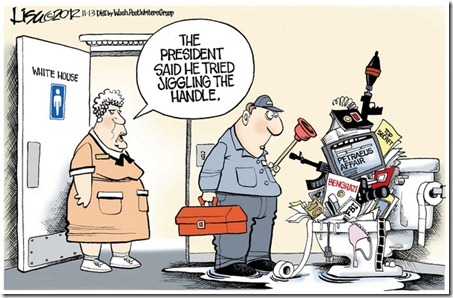To read the entire article click on the title or Story Continued. Enjoy as the world turns.
· Krauthammer: White House ‘Held Affair Over Petraeus’s Head’ For Favorable Testimony On Benghazi –
Syndicated columnist Charles Krauthammer on Tuesday said the White House used David Petraeus’s affair to get the CIA director to give testimony about the attacks on the U.S. consulate in Benghazi, Libya, that was in line with the administration’s position on the matter.
Appearing on Fox News’s Special Report, Krauthammer said, “The sword was lowered on Election Day”
CHARLES KRAUTHAMMER: I think the really shocking news today was that General Petraeus thought and hoped he could keep his job. He thought that it might and it would be kept secret, and that he could stay in his position. I think what that tells us is really important. It meant that he understood that the FBI obviously knew what was going on. He was hoping that those administration officials would not disclose what had happened, and therefore hoping that he would keep his job. And that meant that he understood that his job, his reputation, his legacy, his whole celebrated life was in the hands of the administration, and he expected they would protect him by keeping it quiet.
And that brings us to the ultimate issue, and that is his testimony on September 13. That’s the thing that connects the two scandals, and that’s the only thing that makes the sex scandal relevant. Otherwise it would be an exercise in sensationalism and voyeurism and nothing else. The reason it’s important is here’s a man who knows the administration holds his fate in its hands, and he gives testimony completely at variance with what the Secretary of Defense had said the day before, at variance with what he’d heard from his station chief in Tripoli, and with everything that we had heard. Was he influenced by the fact that he knew his fate was held by people within the administration at that time?
As a point of reference, ABCNews.com reported on September 14:
The attack that killed four Americans in the Libyan consulate began as a spontaneous protest against the film “The Innocence of Muslims,” but Islamic militants who may have links to Al Qaeda used the opportunity to launch an attack, CIA Director David Petreaus told the House Intelligence Committee today according to one lawmaker who attended a closed-door briefing.
This of course was the administration line for almost two weeks after the attacks.
With that in mind, Krauthammer drove his point home further a few minutes later:
KRAUTHAMMER: Of course it was being held over Petraeus’s head, and the sword was lowered on Election Day. You don’t have to be a cynic to see that as the ultimate in cynicism. As long as they needed him to give the administration line to quote Bill, everybody was silent. And as soon as the election’s over, as soon as he can be dispensed with, the sword drops and he’s destroyed. I mean, can you imagine what it’s like to be on that pressure and to think it didn’t distort or at least in some way unconsciously influence his testimony? That’s hard to believe.
If Krauthammer is correct, it’s going to be very interesting to see if and how the Obama-loving media reports it. Story Continued and to watch video:
· Israel kills Hamas commander, bombs Gaza targets –
Israel killed the military commander of the Islamist group Hamas in a missile strike on the Gaza Strip on Wednesday and launched air raids across the enclave, pushing the two sides to the brink of a new war.
The attacks marked the biggest escalation between Israel and Gaza militants since a 2008-2009 conflict and came despite signs on Tuesday that neighboring Egypt had managed to broker a truce in the enclave after a five day surge of violence.
Hamas said Ahmed Al-Jaabari, who ran the organization’s armed wing, Izz el-Deen Al-Qassam, died along with an unnamed associate when their car was blown apart by an Israeli missile. Palestinians said nine people were killed, including a seven-year-old girl.
Video from Gaza showed the charred and mangled wreckage of a car belching flames, as emergency crews picked up what appeared to be body parts.
Israel confirmed it had carried out the attack on Jaabari and warned that more strikes would follow. Reuters witnesses reported numerous explosions around Gaza, with Hamas security compounds and police stations among the targets.
“This is an operation against terror targets of different organizations in Gaza,” military spokesman Avital Leibovitch told reporters, adding that Jaabari had “a lot of blood on his hands”.
Immediate calls for revenge were broadcast over Hamas radio.
“The occupation has opened the doors of hell,” Hamas’s armed wing said. Smaller groups also vowed to strike back.
“Israel has declared war on Gaza and they will bear the responsibility for the consequences,” Islamic Jihad said.
The escalation in Gaza came in a week when Israel pounded Syrian artillery positions it said had fired into the Israeli-annexed Golan Heights amid a civil war in Syria that has brought renewed instability to neighboring Lebanon.
Hamas has been supported by both Syria and Iran, which Israel regards as a rising threat to its own existence due to its nuclear program.
Israel’s intelligence agency Shin Bet said Jaabari was responsible for Hamas’ takeover of the Gaza Strip in 2007, when the militant Islamist group ousted fighters of the Fatah movement of its great rival, the Western-backed Palestinian president Mahmoud Abbas.
It said Jaabari instigated the attack that led to the capture of Israeli corporal Gilad Shalit in a kidnap raid from Gaza in 2006. Jaabari was also the man who handed Shalit over to Israel in a prisoner exchange five years after his capture.
Israel holds a general election on January 22 and conservative Prime Minister Benjamin Netanyahu has come under pressure to respond firmly against Hamas, with residents of southern Israel complaining bitterly about repeated missile strikes
Hamas has been emboldened by the rise to power in neighboring Egypt of its spiritual mentors in the Muslim Brotherhood whom it views as a “safety net”.
Some 1,400 Palestinians and 13 Israelis died in the 2008-2009 conflict. There was a lull in hostilities after that, but the violence has flared again in recent months and Israel has repeatedly warned of dire consequences unless Hamas and its fellow militants stopped rocket attacks.
In the latest confrontation, which appeared to have ended on Tuesday, more than 115 missiles were fired into southern Israel from Gaza and Israeli planes launched numerous strikes. Seven Palestinians, three of them gunmen, were killed. Eight Israeli civilians were hurt by rocket fire and four soldiers wounded by an anti-tank missile.
Helped by Iran and the flourishing contraband trade through tunnels from Egypt, Gaza militias have smuggled in better weapons since the war of 2008-09, including longer-range Grad rockets and anti-tank missiles of the type they fired last week at an IDF patrol vehicle.
But Gaza’s estimated 35,000 Palestinian fighters are still no match for Israel’s F-16 fighter-bombers, Apache helicopter gunships, Merkava tanks and other modern weapons systems in the hands of a conscript force of 175,000, with 450,000 in reserve.
Israel’s shekel fell nearly one percent to a two-month low against the dollar on Wednesday after news of the Israeli airstrikes broke. Story Continued:
· Jobless Claims in U.S. Jumped Last Week After Sandy –
More Americans than forecast submitted claims for unemployment insurance last week as super storm Sandy wreaked havoc on the job market.
Nov. 15 (Bloomberg) — More Americans than forecast submitted claims for unemployment insurance last week as super storm Sandy wreaked havoc on the job market. Applications for jobless benefits surged by 78,000 to 439,000 in the week ended Nov. 10, the Labor Department said today in Washington. The cost of living rose 0.1 in October, the slowest pace in three months, the Labor Department also reported. Betty Liu, Dominic Chu and Sara Eisen report on Bloomberg Television’s “In the Loop.” (Source: Bloomberg)
Applications for jobless benefits surged by 78,000 to 439,000 in the week ended Nov. 10, the most since April 2011, the Labor Department said today in Washington. Several states said the increase was due to the storm that hit the Northeastern part of the U.S. in late October, a Labor Department spokesman said as the data were released to the press.
The extent of the damage means it may take weeks for the underlying trend in firings to again become clear. Before the storm, the labor market was gaining momentum even as year-end domestic fiscal policy uncertainties raised concern among businesses.
“At least a few state labor offices were shut in the prior week so it’s almost as if you have two weeks of claims in one,” said Ryan Wang, an economist at HSBC Securities USA Inc. in New York. “You have a double whammy this week, where people were filing claims they were unable to previously and individuals unable to work for the storm were filing additional claims.”
Stock-index futures dropped after the report, erasing earlier gains. The contract on the Standard & Poor’s 500 Index maturing in December fell 0.1 percent to 1,351.80 at 8:59 a.m. in New York.
Sandy struck the Northeast region, including New York and New Jersey, as it came ashore Oct. 29, and those who lost their jobs because the storm shuttered businesses may keep filing claims in coming weeks.
Sandy’s Impact
The Labor Department spokesman did not name the affected states, citing agency policy not to single out any one area. Today’s report showed a loss of electricity prevented New York offices from taking claims two weeks ago.
In addition, since Monday was a government holiday, three states and territories — Hawaii, Oregon and Puerto Rico — didn’t report claims data, causing the Labor Department to estimate their totals, the spokesman said. Two others, California and Virginia, provided their own estimates.
Claims were projected to rise to 375,000 from the prior week, according to the median estimate of 49 economists surveyed by Bloomberg. Projections ranged from 340,000 to 475,000. The prior week’s reading was revised up to 361,000 from an originally reported 355,000.
Throwing Darts
“When you’re trying to forecast a lot of the economic data, frankly, around a natural disaster like that, it’s like throwing at a dartboard,” said Ward McCarthy, chief financial economist at Jefferies & Co. Inc. in New York, who projected a rise of 385,000. “We knew they would go up, but it was hard to say how much.”
The consumer price index rose 0.1 percent in October, the smallest gain in three months, Labor Department figures also showed today. The so-called core measure, which excludes more volatile food and energy costs, increased 0.2 percent.
Manufacturing in the New York region contracted for a fourth straight month in November as super storm Sandy knocked out electrical power and limited activity, a report from the Federal Reserve Bank of New York showed.
The bank’s general economic index was minus 5.2 this month after minus 6.2 in October. The median forecast of 55 economists in a Bloomberg survey called for minus 8. Readings of less than zero signal contraction in New York, northern New Jersey and southern Connecticut.
Bolstering Builders
While pushing up claims, the storm may bolster homebuilders and other housing repair companies. Sandy’s damage could spur a sales boost similar to the one provided by Hurricane Irene, which added about $360 million in sales last year, executives at Home Depot Inc. (HD) said on a Nov. 13 earnings call.
“The property damage, as we understand it, related to Irene was about $16 billion; the property damage for Sandy is about $20 billion, so it would suggest possibly higher sales, but it’s impossible for us to know right now,” said Carol Tom, the Atlanta-based company’s chief financial officer.
A less-volatile measure of claims, the four-week moving average, rose to 383,750 from 372,000, today’s report showed.
The number of people continuing to collect jobless benefits climbed by 171,000 to 3.33 million in the week ended Nov. 3, the most in more than four years. The continuing claims figure does not include the number of workers receiving extended benefits under federal programs.
Those who’ve used up their traditional benefits and are now collecting emergency and extended payments decreased by about 33,300 to 2.12 million in the week ended Oct. 27.
States, Territories
The unemployment rate among people eligible for benefits rose to 2.6 percent in the week ended Nov. 3 from 2.5 percent. Thirty-four states and territories reported an increase in claims, while 19 reported a decrease.
Initial jobless claims reflect weekly firings and tend to fall as job growth — measured by the monthly non-farm payrolls report — accelerates.
The payroll report released Nov. 2 wasn’t affected by Sandy. Businesses in the U.S. hired 184,000 workers in October, the most since February, indicating they see enough demand to expand even in the face of the tax increases and spending cuts slated for January unless Congress acts.
Still, changes to headcount show the labor market hasn’t been able to gain traction in 2012. Gains in total payrolls so far this year have averaged 157,000 a month, little changed from the 153,000 average for 2011.
A separate survey of households showed the jobless rate rose to 7.9 percent from 7.8 percent in September as 578,000 people joined the workforce is search of a job, swamping the 410,000 gain in employment.
Federal Reserve Chairman Ben S. Bernanke and his policy- making colleagues last month had a detailed discussion about whether the central bank should link its policy of holding the main interest rate at zero to numerical measurements of unemployment and inflation, an approach that participants “generally favored” over the current approach of specifying a calendar date through which rates will remain low, minutes of their October meeting released yesterday showed. Story Continued:
· SURPRISE! JOBLESS CLAIMS UP 78,000 WEEK AFTER ELECTION; PA, OH WORST HIT –
The Department of Labor has announced that new jobless claims rose by a staggering 78,000 in the first week after the election, reaching a seasonally-adjusted total of 439,000. Over the past year, and in the weeks leading up to the election, jobless claims were said to be declining, dipping as low as 339,000, with the media proclaiming that they had reached the “lowest level in more than four years.” Now, suddenly, the news seems far less rosy.
From the Department of Labor press release this morning:
In the week ending November 10, the advance figure for seasonally adjusted initial claims was 439,000, an increase of 78,000 from the previous week’s revised figure of 361,000. The 4-week moving average was 383,750, an increase of 11,750 from the previous week’s revised average of 372,000.
Some of the new claims, especially in New Jersey, were due to Hurricane Sandy–but these were offset by a decline in claims filed in New York. The highest numbers of new filings came from Pennsylvania and Ohio, where there were thousands of layoffs in the construction, manufacturing, and automobile industries.
Both states had been targeted by the presidential campaigns. President Obama highlighted his record of job creation in Ohio in particular, focusing on the automobile industry. The state reported 6,450 new jobless claims in the week after the election–second-highest after Pennsylvania, which recorded 7,766 new claims. Story Continued:
· Texas Instruments Cuts 1,700 Jobs, Winds Down Tablet Chips –
Texas Instruments is eliminating 1,700 jobs, as it winds down its mobile processor business to focus on chips for more profitable markets like cars and home appliances.
Texas Instruments [TXN 28.845 0.085 (+0.3%) ] said in September it would halt costly investments in the increasingly competitive smartphone and tablet chip business, leading Wall Street to speculate that part of the company’s processor unit, called OMAP, could be sold.
The layoffs are equivalent to nearly 5 percent of the Austin, Texas-based company’s global workforce.
“A sale would have been better than a restructuring but a restructuring is certainly better than nothing,” Sanford Bernstein analyst Stacy Rasgon said.
TI has been under pressure in mobile processors, where it has lost ground to rival Qualcomm [QCOM 61.39 -0.3368 (-0.55%) ].
Leading smartphone makers Apple [AAPL 528.80 -8.08 (-1.5%) ] and Samsung Electronics[005930.KS 1331000.00 -24000.00 (-1.77%) ] have been developing their own chips instead of buying them from suppliers like TI.
Instead of competing in phones and tablets, TI wants to sell its OMAP processors in markets that require less investment, like industrial clients like carmakers.
TI is expected to continue selling existing tablet and phone processors for products like Amazon.Com [AMZN 222.36 -0.59 (-0.26%) ] Kindle tablets for as long as demand remains, but stop developing new chips.
“This year, the Kindle runs on the OMAP 4 and next year’s Kindle is slated, we believe, for OMAP 5. We believe that program is well along to completion and do not expect that the termination of OMAP will disrupt those plans,” said Longbow Research analyst JoAnne Feeney.
Amazon had reportedly been in talks to buy the mobile part of OMAP.
TI said it expects to take charges of about $325 million related to the job cuts and other cost reduction measures, most of which will be accounted for in the current quarter.
Its previously announced financial targets for the fourth quarter do not include these costs, TI said.
The company, which has 35,000 employees around the world, expects annualized savings of about $450 million by the end of 2013 from the action.
TI shares rose to $29 in after-hours trading after closing at $28.76, down 2 percent on Nasdaq. Story Continued:
· Debate Over License Plate Readers Grows In Maryland –
BALTIMORE (WJZ) — A wild chase down Interstate 95 ends with a crash. Police got on the trail of the stolen car using controversial technology increasing across Maryland.
Adam May has an exclusive look at the police tool in action.
These days cameras are everywhere, but some do more than watch–they automatically run criminal records.
At the height of Tuesday’s rush hour, police chased a New Jersey car thief–alerted when he raced through the Fort McHenry Tunnel.
“Set off an automatic sensor that detected the plates were on a stolen vehicle,” said Captain Jeff Long, Sky Eye Chopper 13.
Those sensors are called automatic license plate readers, or LPRs. WJZ got an exclusive look at how they work.
“We’re looking for this Mercedes,” said Lt. Craig Hartman, Baltimore Police.
Specially assigned police officers have LPRs mounted on their cars.
“Looks like one of our guys got a hit,” said Det. Brian Ralph, Baltimore Police.
Detective Brian Ralph can scan up to 3,000 tag numbers a shift, searching for stolen vehicles and violent criminals.
“So if someone is looking for a particular vehicle in reference to a robbery or murder or something like that, we can put that tag number into the system and it will hit if the vehicle happens to drive by,” said Hartman, Regional Auto Theft Task Force.
More than 320 LPRs are in use across Maryland. Information about every scanned license plate–even non-criminal–is stored at the Maryland Coordination and Analysis Center. That concerns the ACLU.
“As the data increases over time you get a more detailed picture of Marylanders’ movements. And that is information the government has no business knowing, absent some particular law enforcement need,” said David Rocah, ACLU.
But police say storing information could help in future cases, and the LPRs are way more effective than the naked eye.
“It’s really hard to see the tags for what we do every day and this LPR doesn’t miss a thing,” said Ralph.
It tracks the moves of tens of thousands of Marylanders every single day.
Police are trying to get funding for more plate readers, but the debate over storing the information remains unresolved.
Last month, a New York man–wanted for murder–was caught by a license plate reader on Interstate 95. Story Continued:
· If Every Food Stamp Recipient Voted For Obama, It Would Account For 75% Of His Total – If all 47 million food stamp recipients voted for President Obama, it would account for 75.4 percent of Obama’s 62.3 million votes.
Harry Hopkins, FDR’s close adviser who ran the non-defunct Works Progress Administration (WPA), once described Roosevelt’s strategy as “tax & tax, spend & spend, elect & elect.” He believed that if Roosevelt put everyone on the federal payroll, either through aid or federal jobs, that Roosevelt would never lose. FDR won four presidential elections in a row before his death removed him from office.
Did Obama use his idol’s model to win this election?
Food stamps rolls have grown by nearly 50 percent-by more than 15 million recipients-under the Obama administration. During that same time, the unemployment rate has stayed the same. Either those outside of the workforce have been decimated by the Obama economy or this administration is making a conscious effort to get more Americans reliant on government, or both.
Welfare programs now cost taxpayers a record-high $750 billion. While government “charity” has grown, so has poverty-and so has the Democrats’ poll numbers.
The candidates and their PACs spent $6 billion for the election. Should we add the $750 billion in federal welfare to Democratic campaign spending total?
Not everyone on food stamps votes or votes Democrat (and no one polls this subset of the population), and I don’t want to overstate the effects of the growth in welfare.
If citizens vote in their own personal, short-term interests, with 49 percent of the population receiving some sort of federal aid, Republicans will never win another election. Thankfully many of those 49 percent are elderly voters who want a bright, debt-free future for their children.
In fact, conservatives should take heart that this election was as close as it turned out. It means that at least some of those receiving federal aid are open to conservative anti-poverty ideas.
While liberals throw federal money at voters, conservatives must offer them something more substantial. It’s tough to beat politicians handing out free stuff, but we have to hope that careers and purposeful opportunity will appeal to American’s ethos. Story Continued:
· Demography is destiny – By: Ann Coulter:
Liberals brag about having won the hearts and minds of America, as if, through logic and argument, they’ve persuaded people to accept their bankrupt European socialist ideas.
Democrats haven’t changed anyone’s mind. They changed the people.
More white people voted for Mitt Romney this year than voted for Ronald Reagan in 1980. Barack Obama lost white voters by 20 points — the widest margin since 1984.
But in 1980, whites were 88 percent of the electorate. In 2012, they were 72 percent of the electorate. Not only that, but the non-white electorate is far more Democratic than it was in 1980.
If the same country that voted in 1980 had voted in 2012, Romney would have won a bigger landslide than Reagan did.
Most Americans don’t realize that, decades ago, the Democrats instituted a long-term plan to gradually turn the United States into a Third World nation. The country would become poorer and less free, but Democrats would have an unbeatable majority!
Under Teddy Kennedy’s 1965 immigration act, our immigration policy changed from one that replicated the existing ethnic population to one that strictly favored unskilled immigrants from the Third World. Since 1968, 85 percent of legal immigrants have come from what is euphemistically called “developing countries.”
We can’t admit computer scientists from Spain fleeing their failing socialist nation because we have to make room for a recent Senegalese immigrant’s brother-in-law with no skills but great needs.
Jonas Salk’s parents would be unable to immigrate to America today. But the good news is: Rich liberals and soulless businessmen have no trouble finding cheap busboys, gardeners and nannies! (Whom they underpay, requiring taxpayers to make up the difference.)
If yuppies had to compete with well-educated European immigrants, they might be a little less enlightened on the immigration question. As it is, only unskilled workers, mostly blacks and Latinos, are harmed by our immigration policies.
Because recent immigrants have no skills, they arrive in dire need of government assistance. Their desperation has been an enormous boon to the Democratic Party.Thirty-nine percent of native households receive some form of government assistance. By contrast, 57 percent of immigrant households — legal immigrants — get government assistance. We can’t do anything about the native population, but why on Earth is America taking in immigrants who require taxpayer support?
If you come to America and immediately go on welfare, by definition, you are not a desirable immigrant. Except as a voter for the Democratic Party.
In the last half-century, California’s non-Hispanic white population has been cut in half, from 80 percent to 40 percent. Meanwhile, the Hispanic population has exploded from less than 10 percent to nearly 40 percent — mostly poor Mexicans.
And with that change, California went from being the state that produced anti-tax initiatives, Richard Nixon and Ronald Reagan to a state that is absolutely untouchable by Republicans (see Meg Whitman and Carly Fiorina) and just enacted the highest tax rate in any state.
The same has happened, or is happening, to other states, such as Colorado, New Mexico, Illinois and New York. If Texas ever flips, Republicans will never win another presidential election. The two major political parties will be the Nancy Pelosi Democratic Party and the Chuck Schumer Democratic Party.
Republicans’ low-tax, small-government philosophy will eventually become popular with today’s struggling Hispanics, but not before America is ruined with socialist policies promoted by populist hucksters so strangely beguiling to poor people the world over.
It’s not that poor immigrants think differently about most issues from the rest of us. Try asking a recent immigrant:
– How do you feel about abortion?
It’s taking a life.
– What should we do about criminals?
Lock them up and throw away the key.
– Do you support raising taxes?
No, the government takes too much already.
– How do you feel about overpaid, well-pensioned government workers with no-show jobs?
It ticks me me off.
– Do you support gay marriage?
Absolutely not.
– How are you going to vote?
Democratic.
Most recent immigrants oppose abortion, gay marriage and big government. The problem is that poor, uneducated people — the Democratic base — are easily demagogued into voting tribally.
A white person can vote for a Republican or a Democrat without anyone saying to him, “HOW CAN YOU VOTE AGAINST YOUR RACE?” But that is exactly how poor Hispanics and blacks are pressured into voting Democratic.
Noticeably, the No. 1 issue Obama had in his favor this year was not his policies. It was that a majority of voters agreed with the statement: Obama “cares for people like me.” That’s how Hugo Chavez got elected.
Running Hispanics won’t help Republicans. Ask Gary Franks, Lynn Swann or Michael Steele if being black won them the black vote.
Promoting amnesty won’t help — ask John McCain, who won about the same percentage of the Hispanic vote as Romney did.
Or ask California’s Hispanics, only 4 percent of whom oppose Republican immigration policies. Their main beef with the GOP is that they think Republicans are “the rich.”
The only hope is to run another appealing Republican candidate in four years — when we’re not up against an incumbent president — and return our immigration policy to one that helps America and not just the Welfare Party. Story Continued:
· Obama’s Nightmare – By THOMAS L. FRIEDMAN
The scandal engulfing two of our top military and intelligence officers could not be coming at a worse time: the Middle East has never been more unstable and closer to multiple, interconnected explosions. Virtually every American president since Dwight Eisenhower has had a Middle Eastern country that brought him grief. For Ike, it was Lebanon’s civil war and Israel’s Sinai invasion. For Lyndon Johnson, it was the 1967 Six-Day War. For Nixon, it was the 1973 war. For Carter, it was the Iranian Revolution. For Ronald Reagan, it was Lebanon. For George H.W. Bush, it was Iraq. For Bill Clinton, it was Al Qaeda and Afghanistan. For George W. Bush, it was Iraq and Afghanistan. For Barack Obama’s first term, it was Iran and Afghanistan, again. And for Obama’s second term, I fear that it could be the full nightmare — all of them at once. The whole Middle East erupts in one giant sound and light show of civil wars, states collapsing and refugee dislocations, as the keystone of the entire region — Syria — gets pulled asunder and the disorder spills across the neighborhood.
And you were worried about the “fiscal cliff.”
Ever since the start of the Syrian uprising/civil war, I’ve cautioned that while Libya, Egypt, Yemen, Bahrain and Tunisia implode, Syria would explode if a political resolution was not found quickly. That is exactly what’s happening.
The reason Syria explodes is because its borders are particularly artificial, and all its communities — Sunnis, Shiites, Alawites, Kurds, Druze and Christians — are linked to brethren in nearby countries and are trying to draw them in for help. Also, Sunni-led Saudi Arabia is fighting a proxy war against Shiite-led Iran in Syria and in Bahrain, which is the base of the United States Navy’s Fifth Fleet. Bahrain witnessed a host of bombings last week as the Sunni-led Bahraini regime stripped 31 Bahraini Shiite political activists of their citizenship. Meanwhile, someone in Syria decided to start lobbing mortars at Israel. And, Tuesday night, violent anti-government protests broke out across Jordan over gas price increases.
What to do? I continue to believe that the best way to understand the real options — and they are grim — is by studying Iraq, which, like Syria, is made up largely of Sunnis, Shiites, Christians and Kurds. Why didn’t Iraq explode outward like Syria after Saddam was removed? The answer: America.
For better and for worse, the United States in Iraq performed the geopolitical equivalent of falling on a grenade — that we triggered ourselves. That is, we pulled the pin; we pulled out Saddam; we set off a huge explosion in the form of a Shiite-Sunni contest for power. Thousands of Iraqis were killed along with more than 4,700 American troops, but the presence of those U.S. troops in and along Iraq’s borders prevented the violence from spreading. Our invasion both triggered the civil war in Iraq and contained it at the same time. After that Sunni-Shiite civil war burned itself out, we brokered a fragile, imperfect power-sharing deal between Iraqi Shiites, Sunnis and Kurds. Then we got out. It is not at all clear that their deal will survive our departure.
Still, the lesson is that if you’re trying to topple one of these iron-fisted, multi-sectarian regimes, it really helps to have an outside power that can contain the explosions and mediate a new order. There is too little trust in these societies for them to do it on their own. Syria’s civil war, though, was triggered by predominantly Sunni rebels trying to oust President Bashar al-Assad and his minority Alawite-Shiite regime. There is no outside power willing to fall on the Syrian grenade and midwife a new order. So the fire there rages uncontrolled; refugees are now spilling out, and the Shiite-Sunni venom unleashed by the Syrian conflict is straining relations between these same communities in Iraq, Bahrain, Lebanon, Saudi Arabia, Turkey and Kuwait.
But Iraq teaches another lesson: Shiites and Sunnis are not fated to murder each other 24/7/365. Yes, their civil war dates to the 7th century. And, yes, when they started going after each other in Iraq, they did so with breathtaking chainsaw-nails-pounded-into-heads violence. There is nothing like a fight within the faith. Yet, once order was restored, Iraqi Shiites and Sunnis, many of whom have intermarried, were willing to work together and even run together in multi-sectarian parties in the 2009-10 elections.
So the situation is not hopeless. I know American officials are tantalized by the idea of flipping Syria from the Iranian to the Western camp by toppling Assad. That would make my day, too, but I’m skeptical it would end the conflict. I fear that toppling Assad, without a neutral third party inside Syria to referee a transition, could lead not only to permanent civil war in Syria but one that spreads around the region. It’s a real long shot, but we should keep trying to work with Russia — Syria’s lawyer — to see if together we can broker a power-sharing deal inside Syria and a United Nations-led multinational force to oversee it. Otherwise, this fire will rage on and spread, as the acid from the Shiite-Sunni conflict eats away at the bonds holding the Middle East together and standing between this region and chaos. Story Continued:







